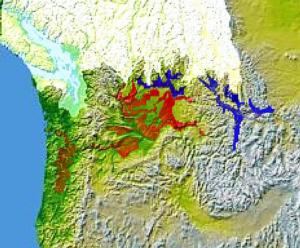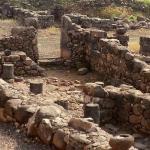There was a real Flood. How deep it was, is open for discussion. But the concept of Biblical authority requires me to believe that a near-extinction of the human race took place in conjunction with a flood of unprecedented scale that was experienced worldwide. The possibility of “authoritative myth” for me is an unacceptable self-contradiction.

Jesus spoke of the Flood as real (Matthew 24:37-39; Luke 17:26-27). Either Jesus knew better and was lying, or he did not know any better, or he was telling the truth. As to how to understand this flood, there are numerous explanations, none of which is without difficulties. But like the light from a distant star, the star may not look exactly like what I see, but there is a real star that is producing what I see.
Genesis 7:19 states in the Hebrew that “the waters grew very, very mighty [emphasis original] upon the earth (or land), and all the high mountains (or hills) were covered under the whole heaven (or sky).” The Hebrew permits, but does not require, the sense that the tops of the Himalayas were covered (15 cubits deep, according to the next verse). But the Hebrew also permits us to read “land,” “hills,” and “sky,” which would allow the sense of a flood that was less than six miles deep.
The word har can mean either mountain or hill. Zion is a har much shorter than Mount Everest, and not much higher than its surroundings; likewise, har in 1 Samuel 17:3 refers to hills in the coastal plain where David fought Goliath. The word eretz (used over 2500 times in the Hebrew Bible) is broad enough to mean “earth” as opposed to “sky / heaven” (Genesis 1:1), “land” in a more local sense (Genesis 12:1), “piece of property” (Genesis 23:15), or even “ground” in a directional sense (Genesis 18:2). Also, there is the question whether “all” in Scripture is always absolute (see Jeremiah 44:12-14, and also Exodus 9, where all the cattle are killed by disease, then more are killed in a subsequent plague by hail).
“If the plain sense of Scripture makes good sense, seek no other sense.” I heartily agree. But a flood six miles deep that covered the Himalayas would require multiple times as much water as we have on earth at present, which would require God to suddenly manufacture all that water out of thin air, and then make it disappear just as fast. Whitcomb and Morris argue in The Genesis Flood for a Himalaya-sized flood that to them accounts for the formation of rock and for fossils (the catastrophic model, as opposed to the uniformitarian model), but Christian geologist Davis Young argues in Creation and the Flood firmly against the catastrophic model.
A variation that seeks to explain the catastrophic amount of water required by the Flood is the hydroplate theory articulated by Walt Brown (Center for Scientific Creation: http://www.creationscience.com/onlinebook/HydroplateOverview2.html). Brown’s explanation is that catastrophic fissures in the earth’s tectonic plates released huge amounts of superheated underground water, much of which came down as rain, and eventually made its way underground again.
On the opposite end of the scholarly spectrum, Mallowan (“Noah’s Flood Reconsidered,” Iraq 26 1964: 62-82) argues for the historicity of a cataclysm in the Fertile Crescent around 3000 BCE. He notes that Noah floats the opposite way from where a huge river flood would carry him. In my opinion, this flood would be far too late to be the Genesis flood.
The human race appears to have gone through a near extinction around the end of the last Ice Age, just when we would predict a flood. The Missoula floods would be one such example. There are also signs of a catastrophic flood in Canada that flooded the St. Lawrence (8750 BCE, according to Al Gore’s Earth in the Balance) and in the Black Sea area (7400 BCE according to Ryan, 5500 BCE according to Ballard), where an early civilization along a much lower freshwater lakeshore suddenly saw the water level rise 200-400 feet, as seawater came rushing in. In his recent book The Long Ascent, physicist Robert Sheldon proposes a catastrophic flooding of a much lower Mediterranean Sea around this same time, at a time where an ice-bound Europe would have driven humans to gather in a much warmer basin. Under this theory, the pre-Flood civilization may be the one that lies behind memories of Atlantis, with the same geological explanation applicable to both.
Sightings of wood structures in the snow high on Mount Ararat have never been substantiated. But near the Turkish town of Doğubayazit (5000 feet elevation), there is a site with traces of a huge ancient boat (now disintegrated), plus anchor stones (http://www.arkdiscovery.com/noah%27s_ark.htm). The relics appear to be no older than 2000 BCE, and could be substantially later. They may be a very early monument to Noah, or a purely geological formation.
Francis Schaeffer states in Genesis in Space and Time that the universality of the flood (although he believes in it) should not be made a test of orthodoxy. I agree. But to me, it is important that a flood of unprecedented proportions came close to extinguishing the human race. I merely seek to correlate that Biblical teaching with the evidence that is available to us.












